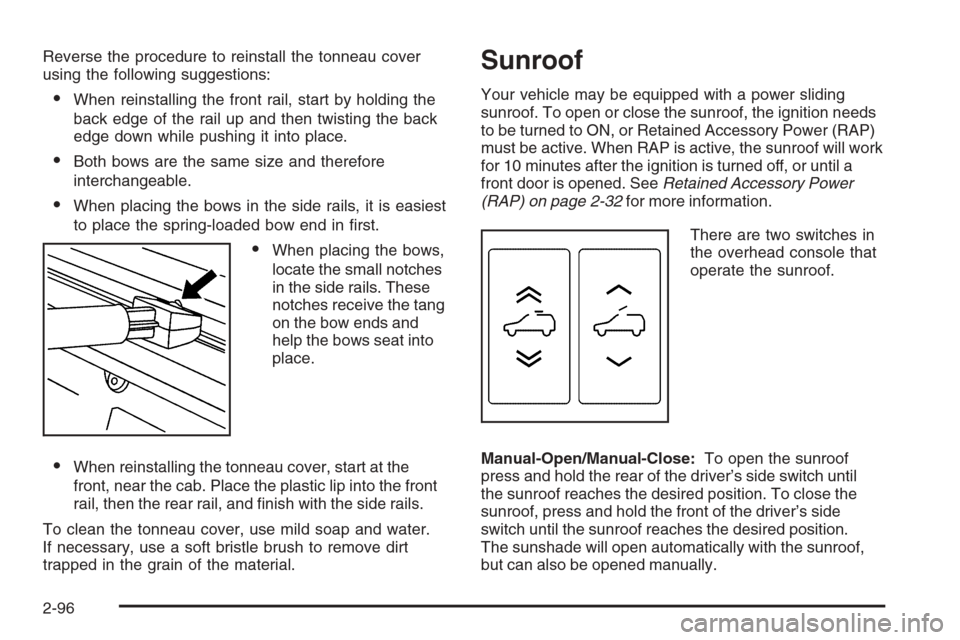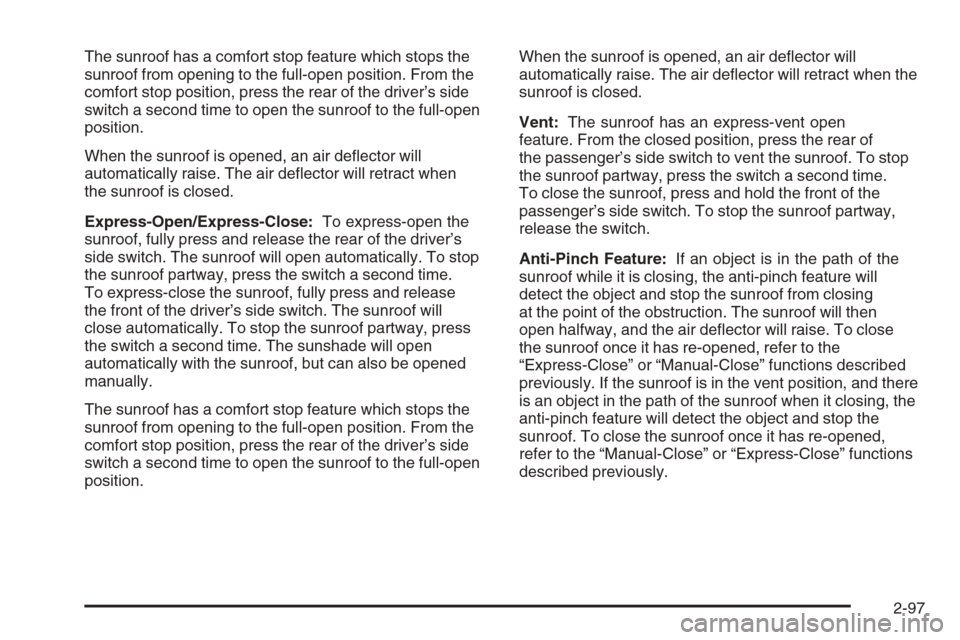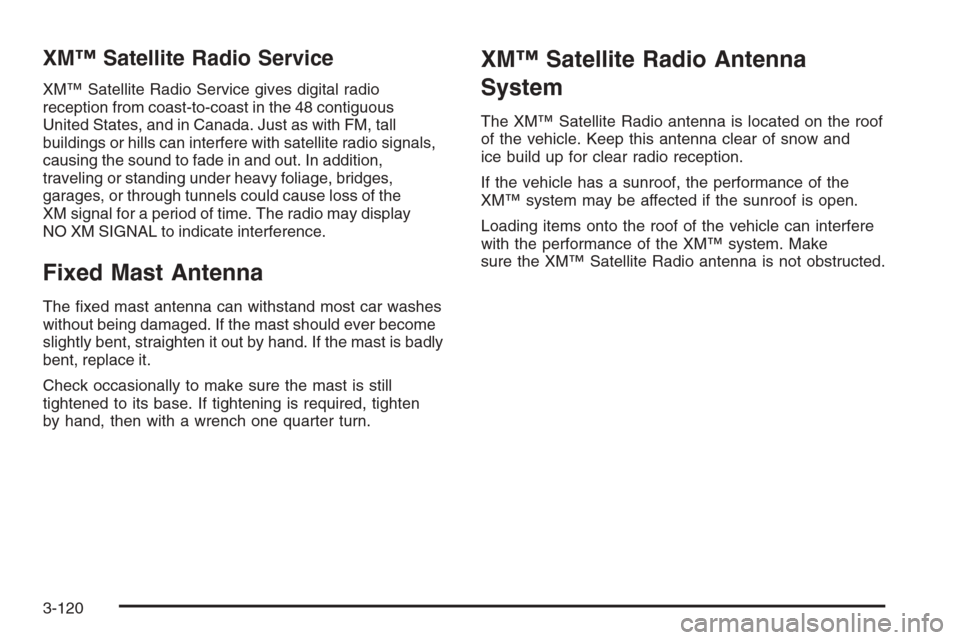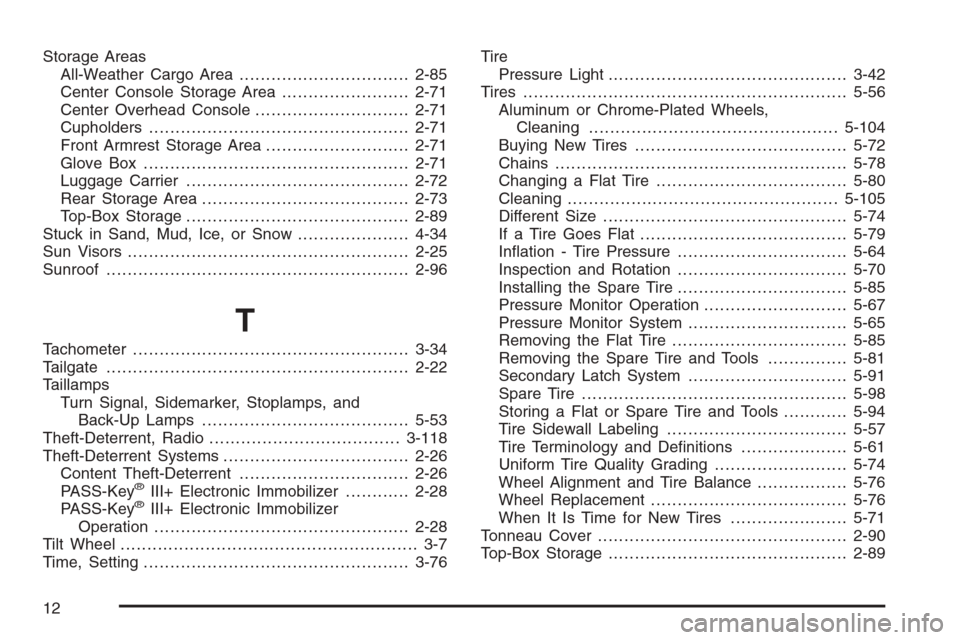2008 CHEVROLET AVALANCHE sunroof
[x] Cancel search: sunroofPage 1 of 528

Seats and Restraint Systems........................... 1-1
Front Seats
............................................... 1-2
Rear Seats
..............................................1-12
Safety Belts
.............................................1-14
Child Restraints
.......................................1-35
Airbag System
.........................................1-60
Restraint System Check
............................1-76
Features and Controls..................................... 2-1
Keys
........................................................ 2-3
Doors and Locks
......................................2-10
Windows
.................................................2-23
Theft-Deterrent Systems
............................2-26
Starting and Operating Your Vehicle
...........2-30
Mirrors
....................................................2-49
Object Detection Systems
..........................2-58
OnStar
®System
......................................2-61
Universal Home Remote System
................2-64
Storage Areas
.........................................2-71
Sunroof
..................................................2-96
Instrument Panel............................................. 3-1
Instrument Panel Overview
.......................... 3-4
Climate Controls
......................................3-21
Warning Lights, Gages, and Indicators
........3-32
Driver Information Center (DIC)
..................3-50
Audio System(s)
.......................................3-75Driving Your Vehicle....................................... 4-1
Your Driving, the Road, and Your Vehicle
..... 4-2
Towing
...................................................4-42
Service and Appearance Care.......................... 5-1
Service
..................................................... 5-3
Fuel
......................................................... 5-5
Checking Things Under the Hood
...............5-12
Rear Axle
...............................................5-47
Four-Wheel Drive
.....................................5-48
Front Axle
...............................................5-49
Headlamp Aiming
.....................................5-50
Bulb Replacement
....................................5-53
Windshield Wiper Blade Replacement
.........5-55
Tires
......................................................5-56
Appearance Care
.....................................5-99
Vehicle Identi�cation
...............................5-107
Electrical System
....................................5-108
Capacities and Speci�cations
...................5-115
Maintenance Schedule..................................... 6-1
Maintenance Schedule
................................ 6-2
Customer Assistance Information.................... 7-1
Customer Assistance and Information
........... 7-2
Reporting Safety Defects
...........................7-14
Vehicle Data Recording and Privacy
...........7-16
Index................................................................ 1
2008 Chevrolet Avalanche Owner ManualM
Page 84 of 528

Object Detection Systems...............................2-58
Ultrasonic Rear Parking Assist (URPA).............2-58
OnStar
®System.............................................2-61
Universal Home Remote System......................2-64
Universal Home Remote System Operation
(With Three Round LED)............................2-64
Storage Areas................................................2-71
Glove Box...................................................2-71
Cupholders..................................................2-71Center Overhead Console..............................2-71
Front Armrest Storage Area...........................2-71
Center Console Storage.................................2-71
Luggage Carrier...........................................2-72
Rear Storage Area........................................2-73
Cargo Cover Panels......................................2-73
All-Weather Cargo Area.................................2-85
Top-Box Storage..........................................2-89
Tonneau Cover............................................2-90
Sunroof.........................................................2-96
Section 2 Features and Controls
2-2
Page 114 of 528

Retained Accessory Power (RAP)
The following vehicle accessories can be used for up to
10 minutes after the engine is turned off:
Audio System
Power Windows
OnStar®System (if equipped)
Sunroof (if equipped)
These features work when the key is in ON/RUN or
ACC/ACCESSORY. Once the key is turned from
ON/RUN to LOCK/OFF, the windows and sunroof
continue to work up to 10 minutes until any door
is opened. The radio continues to work for up to
10 minutes or until the driver’s door is opened.
Starting the Engine
Move your shift lever to PARK (P) or NEUTRAL (N).
Your engine will not start in any other position – this
is a safety feature. To restart when you are already
moving, use NEUTRAL (N) only.
Notice:Do not try to shift to PARK (P) if your
vehicle is moving. If you do, you could damage
the transmission. Shift to PARK (P) only when
your vehicle is stopped.
Starting Procedure
1. With your foot off the accelerator pedal, turn the
ignition key to START. When the engine starts,
let go of the key. The idle speed will go down as
your engine gets warm. Do not race the engine
immediately after starting it. Operate the engine
and transmission gently to allow the oil to warm
up and lubricate all moving parts.
Your vehicle has a Computer-Controlled Cranking
System. This feature assists in starting the engine
and protects components. If the ignition key is turned
to the START position, and then released when the
engine begins cranking, the engine will continue
cranking for a few seconds or until the vehicle starts.
If the engine does not start and the key is held in
START for many seconds, cranking will be stopped
after 15 seconds to prevent cranking motor damage.
To prevent gear damage, this system also prevents
cranking if the engine is already running. Engine
cranking can be stopped by turning the ignition
switch to the ACC/ACCESSORY or LOCK/OFF
position.
Notice:Cranking the engine for long periods of
time, by returning the key to the START position
immediately after cranking has ended, can overheat
and damage the cranking motor, and drain the
battery. Wait at least 15 seconds between each try,
to let the cranking motor cool down.
2-32
Page 178 of 528

Reverse the procedure to reinstall the tonneau cover
using the following suggestions:
When reinstalling the front rail, start by holding the
back edge of the rail up and then twisting the back
edge down while pushing it into place.
Both bows are the same size and therefore
interchangeable.
When placing the bows in the side rails, it is easiest
to place the spring-loaded bow end in �rst.
When placing the bows,
locate the small notches
in the side rails. These
notches receive the tang
on the bow ends and
help the bows seat into
place.
When reinstalling the tonneau cover, start at the
front, near the cab. Place the plastic lip into the front
rail, then the rear rail, and �nish with the side rails.
To clean the tonneau cover, use mild soap and water.
If necessary, use a soft bristle brush to remove dirt
trapped in the grain of the material.
Sunroof
Your vehicle may be equipped with a power sliding
sunroof. To open or close the sunroof, the ignition needs
to be turned to ON, or Retained Accessory Power (RAP)
must be active. When RAP is active, the sunroof will work
for 10 minutes after the ignition is turned off, or until a
front door is opened. SeeRetained Accessory Power
(RAP) on page 2-32for more information.
There are two switches in
the overhead console that
operate the sunroof.
Manual-Open/Manual-Close:To open the sunroof
press and hold the rear of the driver’s side switch until
the sunroof reaches the desired position. To close the
sunroof, press and hold the front of the driver’s side
switch until the sunroof reaches the desired position.
The sunshade will open automatically with the sunroof,
but can also be opened manually.
2-96
Page 179 of 528

The sunroof has a comfort stop feature which stops the
sunroof from opening to the full-open position. From the
comfort stop position, press the rear of the driver’s side
switch a second time to open the sunroof to the full-open
position.
When the sunroof is opened, an air de�ector will
automatically raise. The air de�ector will retract when
the sunroof is closed.
Express-Open/Express-Close:To express-open the
sunroof, fully press and release the rear of the driver’s
side switch. The sunroof will open automatically. To stop
the sunroof partway, press the switch a second time.
To express-close the sunroof, fully press and release
the front of the driver’s side switch. The sunroof will
close automatically. To stop the sunroof partway, press
the switch a second time. The sunshade will open
automatically with the sunroof, but can also be opened
manually.
The sunroof has a comfort stop feature which stops the
sunroof from opening to the full-open position. From the
comfort stop position, press the rear of the driver’s side
switch a second time to open the sunroof to the full-open
position.When the sunroof is opened, an air de�ector will
automatically raise. The air de�ector will retract when the
sunroof is closed.
Vent:The sunroof has an express-vent open
feature. From the closed position, press the rear of
the passenger’s side switch to vent the sunroof. To stop
the sunroof partway, press the switch a second time.
To close the sunroof, press and hold the front of the
passenger’s side switch. To stop the sunroof partway,
release the switch.
Anti-Pinch Feature:If an object is in the path of the
sunroof while it is closing, the anti-pinch feature will
detect the object and stop the sunroof from closing
at the point of the obstruction. The sunroof will then
open halfway, and the air de�ector will raise. To close
the sunroof once it has re-opened, refer to the
“Express-Close” or “Manual-Close” functions described
previously. If the sunroof is in the vent position, and there
is an object in the path of the sunroof when it closing, the
anti-pinch feature will detect the object and stop the
sunroof. To close the sunroof once it has re-opened,
refer to the “Manual-Close” or “Express-Close” functions
described previously.
2-97
Page 300 of 528

XM™ Satellite Radio Service
XM™ Satellite Radio Service gives digital radio
reception from coast-to-coast in the 48 contiguous
United States, and in Canada. Just as with FM, tall
buildings or hills can interfere with satellite radio signals,
causing the sound to fade in and out. In addition,
traveling or standing under heavy foliage, bridges,
garages, or through tunnels could cause loss of the
XM signal for a period of time. The radio may display
NO XM SIGNAL to indicate interference.
Fixed Mast Antenna
The �xed mast antenna can withstand most car washes
without being damaged. If the mast should ever become
slightly bent, straighten it out by hand. If the mast is badly
bent, replace it.
Check occasionally to make sure the mast is still
tightened to its base. If tightening is required, tighten
by hand, then with a wrench one quarter turn.
XM™ Satellite Radio Antenna
System
The XM™ Satellite Radio antenna is located on the roof
of the vehicle. Keep this antenna clear of snow and
ice build up for clear radio reception.
If the vehicle has a sunroof, the performance of the
XM™ system may be affected if the sunroof is open.
Loading items onto the roof of the vehicle can interfere
with the performance of the XM™ system. Make
sure the XM™ Satellite Radio antenna is not obstructed.
3-120
Page 473 of 528

Fuses Usage
24Fuel Injectors, Ignition Coils
(Left Side)
25 Trailer Park Lamps
26 Driver Side Park Lamps
27 Passenger Side Park Lamps
28 Fog Lamps
29 Horn
30Passenger Side High-Beam
Headlamp
31 Daytime Running Lamps
32 Driver Side High-Beam Headlamp
33 Daytime Running Lights 2
34 Sunroof
35Key Ignition System, Theft Deterrent
System
36 Windshield Wiper
37 SEO B2 Up�tter Usage (Battery)
38 Electric Adjustable Pedals
39 Climate Controls (Battery)
40 Airbag System (Ignition)
41 Ampli�erFuses Usage
42 Audio System
43Miscellaneous (Ignition),
Cruise Control
44 Liftgate Release
45 Airbag System (Battery)
46 Instrument Panel Cluster
47 Power Take-Off
48Auxiliary Climate Control (Ignition),
Compass-Temperature Mirror
49 Center High-Mounted Stoplamp
50 Rear Defogger
51 Heated Mirrors
52 SEO B1 Up�tter Usage (Battery)
53Cigarette Lighter, Auxiliary Power
Outlet
54Automatic Level Control Compressor
Relay, SEO Up�tter Usage
55 Climate Controls (Ignition)
56Engine Control Module, Secondary
Fuel Pump (Ignition)
5-113
Page 526 of 528

Storage Areas
All-Weather Cargo Area................................2-85
Center Console Storage Area........................2-71
Center Overhead Console.............................2-71
Cupholders.................................................2-71
Front Armrest Storage Area...........................2-71
Glove Box..................................................2-71
Luggage Carrier..........................................2-72
Rear Storage Area.......................................2-73
Top-Box Storage..........................................2-89
Stuck in Sand, Mud, Ice, or Snow.....................4-34
Sun Visors.....................................................2-25
Sunroof.........................................................2-96
T
Tachometer....................................................3-34
Tailgate.........................................................2-22
Taillamps
Turn Signal, Sidemarker, Stoplamps, and
Back-Up Lamps.......................................5-53
Theft-Deterrent, Radio....................................3-118
Theft-Deterrent Systems...................................2-26
Content Theft-Deterrent................................2-26
PASS-Key
®III+ Electronic Immobilizer............2-28
PASS-Key®III+ Electronic Immobilizer
Operation................................................2-28
Tilt Wheel........................................................ 3-7
Time, Setting..................................................3-76Tire
Pressure Light.............................................3-42
Tires.............................................................5-56
Aluminum or Chrome-Plated Wheels,
Cleaning...............................................5-104
Buying New Tires........................................5-72
Chains.......................................................5-78
Changing a Flat Tire....................................5-80
Cleaning...................................................5-105
Different Size..............................................5-74
If a Tire Goes Flat.......................................5-79
In�ation - Tire Pressure................................5-64
Inspection and Rotation................................5-70
Installing the Spare Tire................................5-85
Pressure Monitor Operation...........................5-67
Pressure Monitor System..............................5-65
Removing the Flat Tire.................................5-85
Removing the Spare Tire and Tools...............5-81
Secondary Latch System..............................5-91
Spare Tire..................................................5-98
Storing a Flat or Spare Tire and Tools............5-94
Tire Sidewall Labeling..................................5-57
Tire Terminology and De�nitions....................5-61
Uniform Tire Quality Grading.........................5-74
Wheel Alignment and Tire Balance.................5-76
Wheel Replacement.....................................5-76
When It Is Time for New Tires......................5-71
Tonneau Cover...............................................2-90
Top-Box Storage.............................................2-89
12